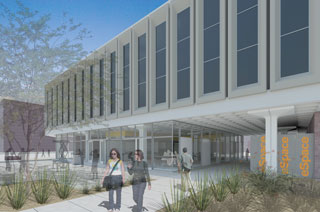
eSpace: Hands-on engineering education


The new engineering design, integration and prototyping studio will replace some existing space in the Engineering Center G-wing with open, engaging space designed to build excitement about engineering and foster collaboration. Image provided by Cannon Design.
Faculty, students and friends of the Ira A. Fulton Schools of Engineering recently gathered for a groundbreaking ceremony to celebrate the start of construction on the new engineering design, integration and prototyping studio at the Engineering Center on ASU’s Tempe campus. The studio is the next step in eSpace—a collective investment in innovative, hands-on learning spaces for students.
The new facility will replace some existing space in the Engineering Center G-wing with open, engaging space designed to build excitement about engineering and foster collaboration especially for freshman engineering students. It will back up to the High Performance Computing Lab, a new facility, which provides students with access to state-of-the-art computing tools.
“This eSpace design studio reflects our commitment to provide tools and facilities that enable our students to do real engineering from day one,” says Paul Johnson, dean and professor of Fulton Schools of Engineering.
The studio will primarily support the newly designed, freshman courses including Introduction to Engineering (FSE 100). Working in teams, students in FSE 100 are introduced to the profession as they learn the engineering design process, engineering models and critical communication skills. These two-credit classes include one hour of lecture and three hours of lab.
Lab time enables students to do real world engineering work from the beginning of their academic experience at ASU. Freshmen participate in multiple team-based projects culminating in a final project during the last half of the semester. These projects include hydroelectric power generators, solar cars, robotics and solar power generation systems.
Teams participating in Engineering Projects in Community Service (EPICS) will also use the studio to plan their entrepreneurial service projects and test proposed engineering solutions.
Inside, two main rooms will have capacity for 40 students each. Each room is equipped with high-end computers to power engineering applications. Interactive design areas, projection screens, whiteboards and writeable glass wall panels that line the exterior encourage collaboration. The majority of the room is modular—moveable tables, rolling cabinets with tools and power cables that can be pulled from above—allowing flexibility to accommodate a wide spectrum of learning experiences from classroom lectures to large-scale design and demonstration.
Finished projects can be showcased in display cases or in front of the glass panes for public viewing.
More information
- new.engineering.asu.edu/espace
- engineering.asu.edu/epicsgold



































